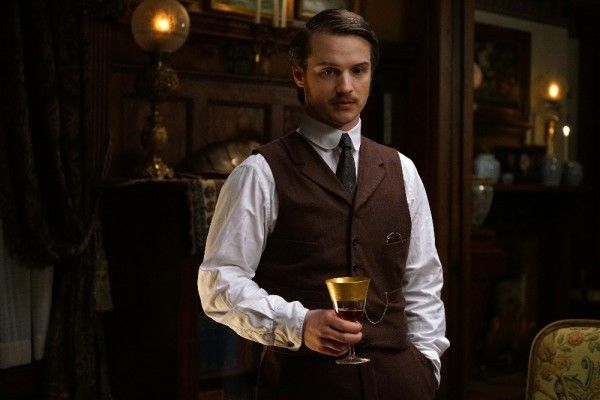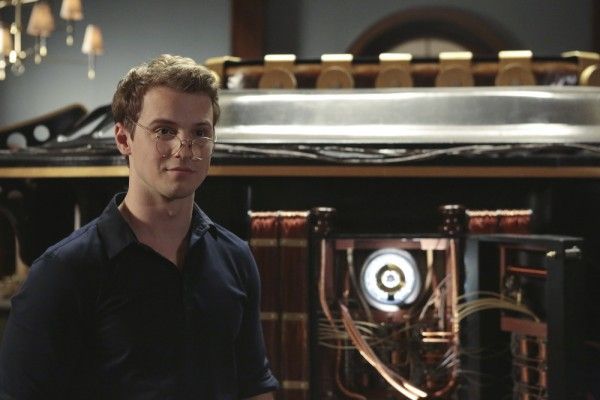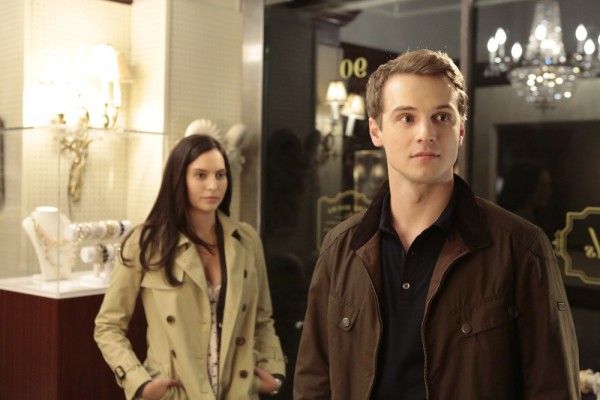What if you found out your best friend was Jack the Ripper, but you have a time machine to help you stop him? It’s not the most relatable premise on TV. If I had a time machine, I would go back to a TV era where not every other show dealt with time travel. And yet, ABC’s Time After Time works better than it has any right to. Most of this is down to the casting, but the series has a depth to it that it cautiously approaches enough to make one think maybe there’s more to this series than its bonkers premise suggests. Maybe.
Though Time After Time feels like one of those “let’s just pull some names from history and put it into the format of a 2000s procedural” show, it’s actually based on a well-received book (and later a film) from the 1970s by Karl Alexander, wherein H.G. Wells (here played by Freddie Stroma) discovers that his best friend John Stevenson (Josh Bowman) is in fact Jack the Ripper. John then escapes to the future in Wells’ newly built time machine, and Wells is quickly in pursuit (the time machine will return to its last location unless you have a key — a major plot device moving forward).
Of the three main elements of Time After Time, two of them work very well. The first is the aforementioned casting of the leads, where Stroma plays Wells as jolly and a full of charm, if ultimately a bit bumbling (in the most endearing way — there’s a joke early on about how he’s mostly let off the hook for his mistakes in 2017 because people think he’s a hipster performance artist). He befriends his love interest, a museum curator — of the H.G. Wells exhibit in 2017 New York, where Wells has followed John — Jane (Genesis Rodriguez), who is similarly charming, a little wary, but tougher than what could easily be a damsel in distress role. Bowman, as John, is handsome, confident, vain, and cold, though he’ll need to be more if he’s going to be an effective villain.
This is where things don’t work quite as well for Time After Time, which very clearly sets up its Murder of the Week procedural aspect as Wells chases John, and John commits a string of murders to both satisfy his own impulses and to torment Wells as he pursues him. The second episode, in particular, is essentially a kidnapping plot that feels like it happens far too soon in the series (it was, of note, written by series creator Kevin Williamson — yes, that Kevin Williamson of Scream and The Following). But there are much more interesting things happening in Time After Time than these familiar TV beats are currently allowing for.
Most of the six or so time travel series on the air look backwards, but few subvert that (Sleepy Hollow was one that did). In Time After Time, Wells is an optimist and a futurist, someone who is excited to go to 2017 and see how things have changed. He embraces societal changes, but there’s a clash between the realities of this time and the utopian society he expected would be in place by now. Instead, it’s an age that plays into John’s impulses more than his own. John points out to him how accessible weapons are, and how — when he stabs Wells in a bar — no one notices or cares. “Isn’t it glorious?” he says gleefully. Only a few moments before, we saw Wells watching TVs all tuned to current events: school shootings, suicide bombers, wars, famine. Tears cascade down his face at the realization that we could not be further from his peaceful dream.
Time After Time’s most sinister lesson is that someone like John — someone who is handsome, rich, and cunning — can get away with almost anything. He calls himself an “amateur” in 2017, and that he has so much to explore in evolving his darkness. Wells is his foil and his opposite, believing that these technological advances and societal freedoms will lead to something good.
But because this is a time travel series, things get bogged down in the second episode with explanations of time paradoxes and changing the course of history. This is well-trod territory, and honestly, if we’re going to believe that both Wells and Jack and Ripper were two hot young time-traveling best friends, I’d rather suspend my disbelief there and skip the paradox mumbo jumbo. This doesn’t need to make sense, and it doesn’t have to. The character drama is more fruitful, or could be: John is asked by Jane if he thinks he can change who he is, though he decides he doesn’t want to. Later at a bar, he chats with a woman he will likely later kill, who says people don’t change because it’s too much trouble. He agrees. But John that makes John a completely one-dimensional villain. He has to wrestle with something to make him more interesting as he toys with Wells. If they are a kind of Sherlock and Moriarty duo, the show has to play up their connection as much as their adversarial stance, but so far it hasn’t.
Still, there are some successful references to a more complicated idea that Wells has time travelled quite a bit in his own future, one that he doesn’t know or remember yet. In one scene, he looks at one of his novels on the shelf in 2017 and is cautioned that it could change how he ends up writing it in the 1800s. He counters, “or does it inform that writing?” These are interesting questions, but without having seen more than the first two episodes, I don’t know whether the show will take this more intriguing route, or bog itself down in time travel and procedural storylines and plot arcs we’ve seen too many times before. Wells was a visionary, and the Ripper a chilling villain. Time After Time has the opportunity to do something worthy of both of their light and dark legacies. Whether or not it does, only time will tell.
Rating: ★★★ Better Than It Should Be — Proceed with cautious optimism
Time After Time premieres March 5th on ABC.







